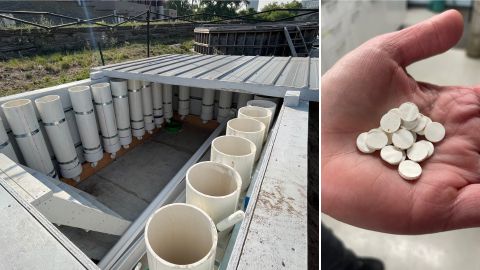How to manage an R&D project
Collaboration can move mountains. My first research director believed in assigning new staff to projects where they had little or no background. His motive was pure: challenge capable people to learn new areas. But his approach unsettled some people, including me. He assigned me to work in catalytic transformations of monosaccharides, an area foreign to me. I was starting at the low end of the learning curve of heterogeneous catalysis and carbohydrate chemistry. My background in organic chemistry helped me get up the carbohydrate curve. But heterogenous catalysis was (at that time) a highly specialized area; I had nothing to build on.

Fortunately, other researchers in the group had this background, and I found common ground with several of them. I brought some new approaches in aqueous chemistry, and they provided expertise in the preparation and evaluation of heterogenous catalysts. Together, we authored patents for new catalytic systems.
The advantages and hazards of collaboration are apparent when a big project requires many people. But as few as five or six participants can get off track in a hurry unless the project is managed effectively from the beginning.
Like most researchers, I never was taught how to manage a project. My education came during my long career with a Chicago-based global R&D and engineering company where I managed many projects. They were large and small, within the company and with other companies or universities, sometimes with organizations in other countries. As I look back on my work, I see guiding principles that were part of my project management style. Here are some of my best practices.
Build a team
It might be nice if someone on high would assign staff members to a team and then you, the project manager, could just lead. This hardly ever happens. Either you gather people on your own initiative to work on your idea, or your employer assigns you to lead a project and it’s up to you to find a team. Either way, this formation phase is a challenge.
- Engage those with crucial skills. This seems obvious, but determine ahead of time what skills are required and get those people. Avoid gathering them along the way.
- Keep the same team. Continuity is important. Make sure everyone understands that you expect them to stay on through the life of the project.
- Engage support staff early. That’s everyone from the analytical groups to glass blowers. You can elevate their enthusiasm simply by including them in the formation stage. They deserve to understand the project and feel part of it.
- Convince your colleagues. Why is the project important? How will it make a difference? What will I learn? What’s the time commitment? They will ask you these questions; be ready with honest answers.
- Honesty in all things. Overselling a project can be fatal and will reflect poorly on you later. I once became involved in a project that had been misrepresented to an outside collaborator. It collapsed quickly with bad feelings all around.
Set expectations
Everyone must understand the project objectives and their role in reaching them.
- Hold a startup meeting. Review the objectives and your expectations. When appropriate, incorporate the team’s feedback and ideas. You won’t have thought of everything; now’s the time to show that you value your team’s input.
- Sow the seeds of enthusiasm. This is a matter of personal style, but don’t be overbearing, demanding or critical. Ask people to take on assignments; don’t order them. Be enthusiastic yourself.
- Initiative is key to progress. Make it clear that you expect members to take the initiative on tasks within their domain. Do not require them to get your approval for everything. They may make mistakes or approach things differently than you would. Accept that; don’t criticize or blame — teach.
- A timeline is good, but not as an edict. The team must reach consensus on the timeline. It must be flexible and subject to revision. The timeline provides a working plan that everyone can refer to.
Communicate
The free flow of information among all team members is crucial. Don’t make yourself the focal point of all communication. If team members aren’t talking to each other, why not? Be concerned.
- Hold project update meetings. These must be regular and frequent; they are key to keeping things on track.
- Have an agenda. Be sure to include opportunities for everyone, including the project leader, to summarize their activities and show their data and progress.
- Manage the meeting. If meetings descend into endless free-for-alls, expect the project team to dread them. Enthusiasm will plummet.
- Produce an outcome. Identify key issues, next steps and action items. Make assignments for follow-through.
Remote collaboration
A project involving multiple organizations and locations may require remote communication for meetings. I find this to be a necessary evil. If at all possible, bring team members face to face, at least occasionally. An effective project team requires comfortable personal relationships.
I once managed a long-term biotechnology R&D project involving team members at a Dutch company. We were big; they were small. They kept mentioning the “elephant and mouse syndrome.” They were afraid of being squashed by our more formidable resources. There was no basis for this, and we worked to reassure them. Everyone spoke English, but it was not the first language of the Netherlands group. I trained myself to be hypervigilant and often halted discussions to clarify and make sure there were no misunderstandings. We agreed to meet in person about three times a year. With each meeting (and dinners and outings), relations improved and true friendships were formed. In a spirit of cooperation, we were able to get through difficult challenges and negotiations.
Do not hold meetings when participants are jet-lagged. Many of us overestimate our ability to perform under jet-lag conditions. I’ve witnessed important mistakes and misunderstandings when people try to hold difficult discussions immediately after crossing five times zones.
In one case, we lost an opportunity for exclusive rights to a new biodesulfurization system because our negotiator had just stepped off a nine-hour flight. He made unwarranted assumptions and failed to grasp subtle details of the discussion. His desire to spend as little time in country as possible (and overconfidence in his abilities) led to trouble and a long cleanup effort. I have no illusions about my own terrible jet lag abilities. I always tried to arrive a day before important meetings; when that was impossible, I struggled.
The important stuff
Now comes that part in all lists of best practices: If you forget everything I’ve said so far, remember these next two points. They are fundamental not only to your project success but also to your ability to form good teams in the future.
- Do not stop. Never, ever allow a project to stop prematurely; maintain momentum. You may encounter seemingly impenetrable road blocks and be tempted to call a temporary halt. Don’t do this. During the weeks or months of inaction, your team will move on to other things. Restarting will be difficult. Momentum will be lost. Find a way to avoid getting stuck. In such situations, I generally find some facet of the project that can continue or create a short-term objective to keep people moving while I work behind the scenes to remove the barriers.
- Spread credit and praise. As the project leader, you are a senior person. Your status is high, so you can afford to stand away from the limelight and direct it toward your team. This is the right thing to do. It builds enthusiasm and loyalty. When a project hits a milestone, celebrate the team’s accomplishments. I had long practiced this principle. But once, a moment of inattention caused a problem. At the end of a yearlong development project, I quickly wrote and distributed an announcement of our success. Unfortunately, I neglected to credit four junior team members in our India office who had made important contributions remotely. They called me on it, I apologized profusely and fixed the announcement, but the damage was done. Lesson: Always pay attention; don’t rush. Giving credit is essential. Beyond that, you must take genuine satisfaction in the success of others. You will be remembered as someone who spreads the glory the next time you want to build a collaborative effort.
Running a project can be gratifying and productive. Success depends on preparation and the project leader’s management style. And when you see a good leader in action, as I have, watch and learn.
Enjoy reading ASBMB Today?
Become a member to receive the print edition monthly and the digital edition weekly.
Learn moreGet the latest from ASBMB Today
Enter your email address, and we’ll send you a weekly email with recent articles, interviews and more.
Latest in Industry
Industry highlights or most popular articles


Strong bonds and a startup
Kevin Lewis’ career path shows that networking is not just about meeting new people to find job leads. Keeping in touch with people from your past can net you opportunities too.

Industry partnership opportunities
The ASBMB has teamed up with Halo to provide ASBMB members fresh industry partnership opportunities each month. The deadline for these is March 31.

Choosing an internship or a fellowship
There are other ways to begin your industry career other than being directly hired to a position. Here we explore the similarities and differences between internships and fellowships in industry.

An academic–industry partnership made possible by Halo
Environmental engineer finds a new use — and new funds — for her lab’s work on a nitrogen-removal system.

Industry partnership opportunities
The ASBMB has teamed up with Halo to provide ASBMB members fresh industry partnership opportunities each month. The deadline for these is Feb. 29.

